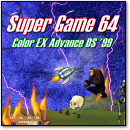[ Retro Scan of the Week ] Fixing My ColecoVision Expansion Module #1 on the Bedroom Floor, 1995
April 22nd, 2013 by Benj Edwards The carpet pretty much looked like that even when it was clean.
The carpet pretty much looked like that even when it was clean.
Here’s a retro-flavored Polaroid instant photo I took of my bedroom floor some point in 1995. I was 13 or 14 at the time, and I had just received a stack of Beatles CDs (upper center-left) the previous Christmas — along with my first CD player, integrated in boombox form, which can be seen seen in the upper right portion of the photo.
But I’m not posting this photo because of Beatles CDs. On the floor sit a number of retrogaming consoles and accessories: to the left is an Atari 5200 console, and in the lower right you can see a ColecoVision and the corner of an Intellivision. There are also a few Atari joysticks, a copy of Yars’ Revenge for the 2600, and three copies of Intellivision Donkey Kong.
If I recall correctly, that wooden drawer sitting near the upper-left of the photo held my Atari 2600 games. I loved the smell of old wood that gently met my nose whenever I sought one of my classic cartridges. The drawer came from a desk that my grandfather bought for my dad when he was a kid in the early 1950s. By the time this photo was taken, the desk was mostly apart, but I had a couple drawer stacks that one could still use as a desk if you placed a board or uncut door across them.
You can also see that I was repairing or tinkering with a ColecoVision Expansion Module #1, which allowed ColecoVision owners to play Atari 2600 games using the ColecoVision as a host. I use that biology metaphor because the Module, an almost fully-contained 2600 clone, latched on like an electronic parasite to the front of the ColecoVision, stealing that console’s power and video connection in the service of its goals. You didn’t even use the ColecoVision’s controller ports — the Module had its own dedicated sockets on the front.
Something about my Module #1 didn’t work, so I guess I was troubleshooting it, which is why it’s apart on the floor (also notice the module’s metal RF shield in the upper-left near the drawer). I bet it was just some dirty switches or cartridge contacts, because I do think I got it working.
It’s amazing what one photo can tell you. There are stories for every item you can see in the print, but I guess I’ll leave it at that.
Well, there is one last detail: that large messy pile of magazines on my bed was my computer and video game magazine collection at the time. This was an age before the invention of bookshelves, you see.
Discussion Topic of the Week: Have you ever taken apart a video game system to fix it? Tell us the story.






April 22nd, 2013 at 2:33 pm
I used to keep my comics on the floor between my desk and dresser. Now I keep them in an Amazon box on a shelf because my cat just has to get into everything and make it his own.
April 22nd, 2013 at 3:38 pm
I didn’t take apart a console to fix it, but I did take apart a consistently malfunctioning, original, gold “The Legend of Zelda” NES cartridge. Strangely, this had normal screws rather than the usual 3.8mm security bits normally seen on NES carts. Taking it apart didn’t really do much good, though.
April 22nd, 2013 at 3:52 pm
So that module was 12 years old in 1995, the year the Playstation came out. I’ll bet the Coleco felt like a dinosaur even then.
Twelve years ago from this year would be 2001, the year the GameCube and the original XBOX launched. Those things seem pretty crude by today’s standards, especially since a mobile phone can play Dreamcast games!
What will we be playing with or fixing in 12 years? Will the Colecovision still work?
April 22nd, 2013 at 5:13 pm
Wow! Just last weekend I invited my buddies over for some Colecovision gaming. It had been about 30 years since we played. Miner 2049er, Looping, Zaxxon, Ladybug, and my favorite – Pepper II! I am convinced I have the all time high score on Pepper II. For whatever reason I can play for hours on end without dieing. Ahhhh – Colecovision on a 50″ plasma!
April 23rd, 2013 at 7:04 am
Did you ever get an Atari 5200 controller that actually worked?
The Angry Video Game Nerd had a pretty funny rant about that console and its broken peripherals, lol.
April 23rd, 2013 at 7:15 am
Dan,
Yes and no, Dan. My 5200 controllers kinda worked, but not very well. Those were some horrible controllers. Over-complex mechanically, fragile, and extremely vulnerable to failure.
They have these flexible membrane switch pads inside that tend to crack and break, and the conductive rubber pads under the flexible buttons hardly make contact on them even when they’re not broken. The joystick mechanism is very complex and easy to break as well.
It’s really neat that they have analog joysticks, but I don’t recall that many 5200 games used the functionality. Maybe Centipede. The system shipped with Pac-Man as a pack-in, and those joysticks were abysmal for that purpose. The 5200 physically represented just about everything wrong with Warner-owned Atari circa 1982.
April 23rd, 2013 at 7:18 am
Carpeted floor? I guess ESD was not a concern to a 14 year old!
April 23rd, 2013 at 10:48 am
I wish I had a button I could press (every so often) that transported me back to being 14 years old… and surrounded by my old NES and games, and Nintendo Power Magazines.
Think about it. We are the last generation who can say from experience, that it’s possible to have a happy childhood without the internet.
April 23rd, 2013 at 8:14 pm
I once opened up an Intellivision hand controller. One of the buttons was pushed in and made permanent contact. I found small metal half-dome and inserted it between the layers of mylar. It was a very good fix. The button came back to life and lasted many more years.
April 24th, 2013 at 4:57 pm
I’ve opened my SNES to get a piece of erector set out that fell in the cartridge ejection button slot. I’ve opened my Gameboy Color to get some pieces of a sticker that got into the case. I saw them, since it’s a clear purple one.
I’ve opened most of my game systems at one point or another just to see what they look like in the insides. Never actually effected a repair to my recollection.
April 25th, 2013 at 2:53 am
Yeah, I’ve taken a number of video game consoles apart in order to fix them. Most recently, I dismantled a Dreamcast that I got for cheap on eBay. It had difficulty reading discs, so I tried recalibrating the laser using nothing but a pair of nail clippers, which didn’t help much. After some troubleshooting, I determined that the biggest problem was that the lid was just barely missing contact with the switch that tells the console that the lid is closed. So I ripped out the spring mechanism that makes the lid pop open, which allowed the plastic gear to make contact with the switch. Now I have to open it manually, but it solved the problem.